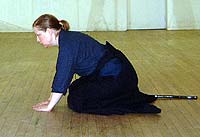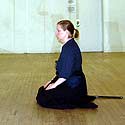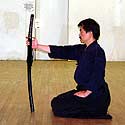From The Beginning: The Importance Of Reishiki In Iaido
By Deborah Klens-Bigman,Ph.D.

A story: Three American senior martial arts students went to Japan in
the company of their Japanese teacher. They stayed for several weeks,
went sightseeing, and generally had a wonderful time. There was only one
disappointment: they didn’t visit any Japanese dojo.
After their initial distress, they decided among themselves that the
teachers they might have visited were probably busy or out of town. Some
time later, I had an opportunity to ask their teacher why the group did
not meet any other teachers while in Japan.
The teacher mentioned one member of the group by name and said, “His
manners are terrible. That’s why I didn’t take them.”
He didn’t mention the group’s skill level (which was pretty
high, I thought). Skill didn’t matter. Without proper manners, one
member of the group could disgrace him and his U.S. dojo. He decided not
to take the risk.
As the above story illustrates, without good manners, you can’t
get very far in martial arts. This is especially true for iaido. Iaido,
the Japanese art of drawing the sword, is the modern descendant of earlier
techniques taught to inflict deadly injury on someone else. Certainly,
in the time before the Meiji era (1868 - 1912)in Japan, the potential
for deadly misuse was high.
Like the European Code of Chivalry, ethical standards and texts evolved
to train the minds of swordsmen as well as their bodies to impart judgment
and compassion as well as skill in the use of a surgically sharp blade.
Though there were numerous violent incidents, the effectiveness of these
efforts is evidenced by the relative peace of the Tokugawa era (1602 –
1867) and the fairly smooth transition to imperial rule in 1868.
Sword-drawing arts that later gave rise to iaido and kendo preserved at
least some of these aspects of ethical behavior. In modern kendo, rules
apply to ensure participants’ safety as well as good sportsmanlike
conduct. In iaido, different styles include various mechanisms to ensure
a meditative and reflective mindset designed to allow the iaidoka (one
who practices iaido) to contemplate life and death and consider compassion
in the use of a sword.
Though iaido is a modern descendant, many iaidoka use real swords if
they have them. Especially in non-Japanese dojo that may not reflect a
less-violent culture (e.g. the U.S.), disciplining one’s ego becomes
of paramount importance.
One of the most obvious examples for observers to an iaido dojo of this
sense of circumspect contemplation is reishiki, the bowing ceremony.
Reishiki not only teaches respect and self-control, it sets off time
in the dojo from time in ordinary life. As many anthropologists studying
ritual have pointed out, an opening/closing ritual “sets off”
the time in between as “special time.” In terms of iaido practice
reishiki sets off the dojo as a place to recognize practices and hierarchies
not normally considered in everyday life. For example, a construction
worker may become a dojo chief instructor, a successful attorney may be
gently cuffed around as an unranked beginner.
Iaidoka may do partner practice with wooden swords, a potentially dangerous
activity. Reishiki signals an atmosphere of mutual trust in the dojo wherein
these activities may safely take place.
Japanese books on iaido show proper sword etiquette and what a proper
bow looks like. They rarely include further explanation because it is
assumed the student is working with a teacher who can give further explanation
if necessary.
Additionally, bowing is still such an important part of the Japanese
cultural landscape that training in basic etiquette is not usually necessary.
English language books may show proper handling of the sword but may not
show a proper bow. Though a Western iaido teacher should be sufficiently
trained to show proper reishiki to his students, there are any number
of “textbook warriors” out there whose only source of information
is a book. Maybe this essay can fill in the gap.
There are many variations on reishiki observed by various styles and
even variations from one dojo to the next, but, generally speaking, iaido
reishiki seeks to honor three aspects of practice: acknowledgment of a
kamidana or shinzen, the teacher and the sword. Reishiki is preceded by
a moment of “mokuso” or quietness, whether standing or sitting
(some groups prefer “zazen” or sitting for a few moments of
meditation).
A Proper Bow
While it seems less important to non-Japanese, learning to bow properly,
especially if the dojo is affiliated with a Japanese dojo (or hopes to
affiliate with one) is possibly more important than any iaido technique.
Bowing properly will open doors. Not bowing properly shows disrespect
and can close them instead.
|
A bow from seiza (kneeling position)
is most formal. First, sit properly in seiza (back straight, shoulders
relaxed, knees not more than one fist apart, gaze level, chin slightly
tucked in). Hands are placed on top of the thighs.
At New York Budokai, we place the hands just in front of the crease
where the top of the thigh meets the body. |
|
To start the bow, bend forward(back straight)and
slide the left hand from the thigh to the floor,fingers together,thumb
out. Next slide the right hand to the floor. The thumbs and forefingers
of both hands touch slightly, creating what Tamiya ryu teacher Michael
Alexanian calls an “arrowhead shape” on the floor. The
back and arms remain straight. |
The iaidoka
bows by lowering the forearms to rest on the floor, keeping the
back straight and head properly aligned. Outside of being more
polite than showing the back of your head, keeping the head and
neck aligned with the back allows the iaidoka to see peripherally
all around. To recover from the bow, simply straighten the arms,
keeping the hands on the floor. Slide the right hand back up the
thigh first, then the left hand as you straighten the back and
return to the starting position. |
 |
Click on the
image to see the full sequence |
|
|
A standing bow is executed similarly with the back straight,
head and neck aligned, but the hands remain relaxed at the sides. Once
again you should be able to peripherally observe your surroundings.
In particular, you should be able to observe the person or thing you
are bowing to.
There is a lot of protocol attached to the length of time it takes to
bow and how deeply one should bow. Bowing too quickly or shallowly could
be considered disrespectful if directed to the shinzen (or kamidana)
or a teacher. Bowing too deeply to a fellow dojo member could considered
ostentatious or at least obsequious.
While every group has its own bowing protocols, generally the order is
the same: shinzen or kamidana first, teacher second and sword last to
begin class. The deepest, longest bow is always to the shinzen or kamidana,
less for the teacher and the sword. At the end of the class, the order
is reversed: sword, teacher, shinzen or kamidana. Iaido groups associated
with the various kendo federations affiliated with the Zen Nihon Kendo
Renmei/Zen Nihon Iaido Renmei have association-wide protocols. Smaller
groups have their own variations.
Though individual details vary, if one goes from one sword dojo to another,
the basics of reishiki are similar enough that to be familiar with one
is sufficient to follow along in most of the others. The following outlines
reishiki at New York Budokai, and generally follows Muso Shinden ryu protocol.
Shinzen
|
The shinzen
consists of a piece of calligraphy by our dojo founder,
Otani Yoshiteru. The inscription reads: “Great Universe,
Great God Spirit.” |
|
Many traditional dojo have a kamidana or kamiza. The aikido dojo kamidana
is probably most familiar to U.S. martial artists. It is a small shelf,
located well above the dojo floor which has a photo of Ueshiba Morihei
and perhaps a vase of flowers or some other offering. Rather than a kamidana,
New York Budokai uses a shinzen to designate its spiritual focus.
Otani Sensei once explained to me the divine exists all around us, and
the shinzen provides a focus for meditation practice. Though the sentiment
expressed bears some relation to Shinto, I like to think of the shinzen
as reminding me of my place in the universe, which is very, very, very
small. Iaido, with its 400-year history, has a slightly larger one, but
admittedly, the universe pretty much overwhelms everything on a human
scale.
As a matter of dojo custom, the newest member present is charged with
both putting up the shinzen before and taking it down after class. On
the one hand, taking care of the shinzen could be considered an honor,
but mostly, it is a responsibility and therefore good training for a newcomer.
If this duty is overlooked (a very rare occurrence) the malefactor endures
public embarrassment for being forgetful, which is generally enough to
ensure it won’t be forgotten again.
As is common in many dojo, New York Budokai members line up, seated
in seiza, with the teacher in front. The highest ranked student is to
the teacher’s left. The teacher sits with his back to the shinzen
to start. After a moment of mokuso or zazen, the teacher turns to the
shinzen and announces, “Shinzen ni rei!” and leads the first
bow. The students always follow the teacher’s lead in bowing. It
is considered rude to finish any bow before the teacher has finished (yet
another reason why being able to see peripherally during bowing is very
useful).
Teacher
Obviously, our most important teacher is Mr. Otani, the dojo founder.
When he is present the bow to the teacher is always directed to him. Generally
speaking, as with many martial arts dojo, the highest-ranked person is
the teacher of a given session and is addressed as “sensei”
while on the floor.
While some martial arts groups are less traditional with the use of the
word "sensei," at New York Budokai we follow generally-accepted
custom and consider "sensei" to be an honorific designation
for a teacher. It is also used to refer to someone whose higher learning
commands your respect (in Japan, a patient addresses his doctor as "sensei").
Technically, it is used only by a student to address her own teacher.
A teacher never refers to himself as "sensei." Likewise, it
is unnecessary to refer to another teacher not one's own as "sensei"
unless the person is present and you wish to be exceptionally polite.
In most circumstances, however, it would not be polite to address someone
else as "sensei" in the presence of your own teacher.
After the shinzen bow, the teacher turns again to face the students.
The highest-ranked student in the line gives the command “Sensei
ni rei!” and leads the bow to the teacher, who also bows to the
students at the same time.
Sword
We keep the sword at the right side (edge facing away) for the bows to
the shinzen and teacher. It is then picked up with the right hand and
placed with the butt end touching the floor in front and center of the
knees. The sageo (a cord attached to the saya) is allowed to fall naturally.
The kurigata (the hole that the sageo passes through) is to the right,
and the edge faces away from the iaidoka. The left hand takes control
of the sword by holding the tsuba (guard) and the right hand passes down
the side, smoothing the sageo as it goes.
The iaidoka then returns the right hand to holding the sword and passes
the left hand down, the thumb pressing the sageo. When the left hand reaches
the bottom of the saya, the sword is picked up and placed on its side
on the floor in front of the iaidoka.
The tsuba is to the right and the edge faces away. The blade is centered
to the person (in a crowded lineup the sword may be angled so the tsuba
is further away). The hands are returned to the top of the thighs in preparation
for the bow. Sometimes the teacher gives a command, but more often the
bow to the sword is commenced in silence.
After the bow,
the sword is picked up to stand on its end again, the right hand
gathers up the sageo and the sword is either returned to the right
side or tucked into the obi to begin practice, depending on instructions
from the teacher. |
 |
Click on the
image to see the full sequence |
|
|
As in many dojo, there are numerous other short bows that take place
during the course of a practice. Partners bow to each other before and
after kumidachi (kata for two persons with wooden swords) exercises. Persons
entering and leaving the floor during practice bow on their way in and
out. If a practice is underway and a higher-ranked person appears late,
it is customary for the group to stop practice, remove their swords from
their obi (sash) and greet the newcomer with a bow before resuming practice.
If a lower-ranked person is late for practice, they are expected to perform
reishiki on their own before joining the group. Likewise, someone leaving
early is expected to do the same.
Muso Shinden ryu no longer has a specific hierarchy, so variations in
reishiki have evolved through a number of very highly-ranked teachers.
However, it is largely the same from group to group. Regardless of the
possible variations, showing proper respect to the dojo and fellow dojo
members and teachers is always essential, the more so when the art is
as potentially dangerous as iaido.
Learning to bow properly in the dojo will also serve you well should
you or your group ever have the opportunity to visit Japan or (even better)
to properly comport yourself should your group be lucky enough to have
a visit from a Japanese teacher.
Copyright 2002 Deborah Klens-Bigman
About the Author:
Deborah Klens-Bigman is Manager and Associate Instructor of iaido at
New York Budokai in New York City. She has also studied, to varying extents,
kendo, jodo (short staff), kyudo (archery) and naginata (halberd). She
received her Ph.D in 1995 from New York University's Department of Performance
Studies where she wrote her dissertation on Japanese classical dance (Nihon
Buyo). and she continues to study Nihon Buyo with Fujima Nishiki at the
Ichifuji-kai Dance Association. Her article on the application of performance
theory to Japanese martial arts appeared in the Journal of Asian Martial
Arts in the summer of 1999. She is married to artist Vernon Bigman. For
FightingArts.com she is Associate Editor for Japanese Culture/Sword Arts.
|